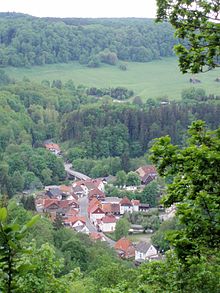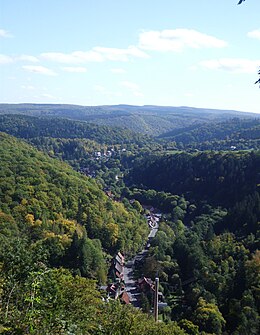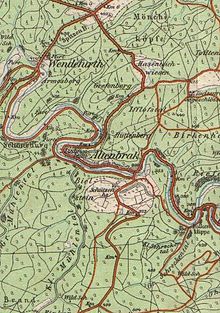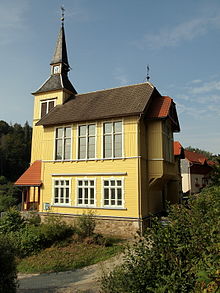Altenbrak
|
Altenbrak
City of Thale
|
|
|---|---|
| Coordinates: 51 ° 43 ′ 36 ″ N , 10 ° 56 ′ 6 ″ E | |
| Height : | 304 m |
| Area : | 19.43 km² |
| Residents : | 332 (Jan 23, 2017) |
| Population density : | 17 inhabitants / km² |
| Incorporation : | July 1, 2009 |
| Postal code : | 06502 |
| Area code : | 039456 |
|
View of Altenbrak from the Schöneburg viewpoint
|
|
Altenbrak is a district of the town of Thale in the Harz district in Saxony-Anhalt , Germany. It was recognized as a climatic health resort in 2002 .
geography
The place extends in a valley that opens from east to west, about 1.6 km along the Bode . The Wendefurth dam , which is part of the Rappbodetalsperre , is three kilometers away. Out of nature, Altenbrak had to develop into a downright street village.

The Wendefurth district is in front of the dam . Altenbrak's immediate neighbors are Allrode , Blankenburg (Harz) , Cattenstedt , Friedrichsbrunn , Hasselfelde , Treseburg , Wendefurth, Wienrode . Almsfeld, Todtenrode and the hunting lodge Windenhütte are in the immediate vicinity .
history
General overview
According to the chronicler Gustav Adolph Leibrock, Todtenrode ( Dovenrode ), located above Altenbrak, was mentioned around 970 as an agricultural property. Centuries earlier, before miners and smelterers settled in the Bodetal, people were busy with agriculture and cattle breeding in the village . (Remnants of this settlement are still recognizable for those who are familiar with the area). Margrave Eckhard - also Eckard or Eckert - as the owner gave it to the Gernrode monastery , which Margrave Gero had donated in 959.
As a settlement and extraction site for ore on the exposed passages , Altenbrak most likely already existed in the 10th century. The racing oven was already known and used in a kind of village community. As is well known, the Ramberg massif with its veins reached as far as Altenbrak. Altenbrak was founded between 1227 and 1448 (according to local chroniclers Günther Mros and Werner Schomburg). The place owes its origin to the mining and metallurgy industry . The first hut construction began around the end of the 14th century - probably on the site of today's Hütteplatz. Altenbrak was first mentioned in 1448 as a hut location. In the first mining period, the rock was broken out of the earth's surface in an open pit . The hydrographs were followed by opencast mines, which are known today as “ ravines ”.
In the chronicle of the city and the principality of Blankenburg , the county of Regenstein and the monasteries Michaelstein and Walkenried , edited by Gustav Adolph Leibrock according to documented sources, it says on pages 383/384: “Altenbrack is a parish in Wienrode, an old hut town with its huts Destroyed by water or fire and rebuilt further down in the grooves, which can still be seen in ditches and slag heaps. Later this also came in and the hut was built in the old place, the old BRACKE. It comes in 1448 as Oldendorp im graef. Precesse of division, like the other huts, was leased by the counts, then given away as a fief; as such a fief, it was owned by the smelter Hans Hahne in 1574, who transferred it to Valentin Böttcher, mayor of Blankenburg, for 1300 thalers . "
In 1725 the Altenbraker hut leaseholder Johann Heinrich Grofe was involved in the process of the 4 main factors .
After the last hut was closed in 1867 , the population became impoverished. Tourism developed later, benefiting from the protected location of the place.
Altenbrak in World War II
Altenbrak was also involved in the armed conflict. Right at the beginning of the war, around 15 families from Saarland and the Westwall areas were evacuated to Altenbrak. But there were no job opportunities, and housing around 50 people was not an ideal solution for everyone involved. In addition, after the bombing in the cities, there were those who had been bombed out and who sought protection, mostly women and children; the fathers were at the front .
The place got a population increase of at least 200 to 250 people during this time. Around 15 more families came towards the end of the war: refugees from East Prussia , Silesia and the Sudetenland . On April 18, 1945, American troops , coming from Hasselfelde via Cellestrasse, shelled the small town with artillery and tanks and did great damage. Ten people died. The people fled to the former mining tunnels or to the inaccessible forest areas in the Bodetal. In the afternoon three American tanks moved over Cellestrasse to the Bodebrücke, two passed the wooden Bodebrücke, the third tank broke in with the bridge. It was thus destroyed and impassable. After the fighting ended, a total of 39 German soldiers had to be buried in the Altenbrak cemetery. The “Bergwiese” - today a recreational area - was transformed in the following days into a large provisional prison camp for 5,000 to 6,000 German soldiers.
Altenbrak has 17 men to complain about his own dead and missing. A war memorial is located in the Altenbrak cemetery .
New beginning after the Second World War
On September 3, 1945, the state government of Saxony-Anhalt issued an ordinance on the implementation of the democratic land reform :
- the ducal forests and lands became public property ; Blankenburg Castle (Harz) came into the possession of the state of Saxony-Anhalt;
- In Altenbrak, 20 citizens received parcels of land (approx. 3 hectares for each) as farm forest;
- the locations: Celle, Hanover, Kl. Mühlental, a total of 57.69 ha;
- the community also received some areas: hammock forest (now forest stage), Schützenplatz , Kuhtrift im Roland;
- the ducal lands were also divided into parcels : the Altenbraker, who previously leased this land, now became the owners .
From 1943 to 1945 the ducal forest in Roland operated two small brick kilns for charcoal , which were operated by two residents. The charcoal was needed to drive the trucks - for lack of gasoline or diesel. In Altenbrak alone, three trucks were used to transport necessary goods. They drove the " charcoal gasifier ", i. H. with wood gas instead of gasoline or diesel. In 1948 the operation with these kilns for charcoal was stopped.
Under the leadership of Mayor Erich Hoffmann, who came from Hasselfelde, the population took the initiative in 1946 to repair the war damage in order to develop the town as a tourist and recreational center. A house bought by the community was converted into a community office and a treatment and consultation room for doctor and dentist was set up in it. The mayor was assisted by two employees and an accounting officer .
From July 5th to 8th, 1951, the place celebrated its 500th anniversary. Altenbrak has been a climatic health resort since June 22, 1949 . For many decades Altenbrak called itself the pearl of the Bodetal .
On July 1, 2009, the previously independent community of Altenbrak was incorporated into the city of Thale.
politics
In the past, Altenbrak and the neighboring town of Treseburg formed a community headed by a community leader from Altenbrak. By an ordinance of Duke Wilhelm von Braunschweig on January 28, 1835, Treseburg became an independent municipality and from that time had its own municipality leader. Community leaders were representatives of the bourgeoisie, which was represented by the numerous artisans, restaurant owners, merchants and boarding houses. The administrative tasks of a community leader were still minor at that time. So he carried out this activity “part-time”, so to speak, and had no assistants to do any paperwork, on the contrary: he was mostly still responsible for the activities of the registrar. He was only responsible for a community servant . He ran errands, was responsible for the water supply and was the “crier” of notices. With a brass bell attached to a handle, he announced his information loudly and clearly. A “crier” continued to work in the same way until after the Second World War , until Altenbrak received a local call system in 1950 .
The community leaders were elected by the residents for six years and confirmed by the district administration. Thus we read in an announcement of the non-profit weekly newspaper for Blankenburg and the Harz from November 20, 1869: “The master tailor August Röbbeling , who was elected to be the head of the Altenbrak community from January 1, 1870 to 1876 , will be there as such on December 15. Mts. confirmed and sworn. "
The August Röbbeling mentioned here held the office of mayor until the end of the First World War and was replaced by his son, the master tailor Otto Röbbeling.
mayor
- 1927–1933 Wilhelm Steffen (SPD). After the seizure of power by the NSDAP on 30 January 1933, to put first the former mayor Otto Röbbeling again until then the local branch of the NSDAP, Karl Leggewig, took office and it held until the end of World War II.
- Karl Schomburg ( SPD ) became the first mayor after the Second World War in 1945 .
- From 1946 Erich Hoffmann ( KPD ) came to Altenbrak as his successor, who was deposed in November 1958.
- 1959 for two months (provisional) Walter Koch ( SED ).
- 1959 for two months (provisional) Bernard Prochnau (SED).
- 1959–1965 Otto Ebeling (SED).
- 1965–1980 Otto Elsner (SED).
- 1980–1986 Dieter Lang (SED).
- 1986–1989 Jörg Wenzel party unknown.
- 1989–1993 Konrad Pisalski party unknown.
- 1993–2000 Manfred Dott ( CDU )
- 2001–2008 Konrad Pisalski (WG).
- 2008–2009 Ralf Trute.
badges and flags
The coat of arms designed by the Magdeburg heraldist Jörg Mantzsch was approved on July 10, 2008 by the district of Harz and registered under no. 32/2008 in the Saxony-Anhalt state archive .
Blazon : "Split of gold and green, in the front a torn green spruce, behind a half silver watermill wheel at the gap, in the blue corrugated foot a silver trout."
The colors of the former municipality are - based on the tinging of the coat of arms - the colors green and gold (yellow). The flag has two stripes, the left stripe is green and the right stripe is yellow. On the stripe flag, the top stripe is green and the bottom stripe is yellow. The coat of arms is placed in the middle.
Economy and Public Services
tourism
One of the main economic factors of the place are the spa guests. Between 1946 and 1988 the number of guests increased massively:
- 1946: 1,290 spa guests.
- 1949: 4,217 spa guests.
- 1955: 7,859 spa guests.
- 1970: 10,579 spa guests.
- 1977: 17,200 spa guests.
- 1988: 25,375 spa guests.
History of the fire department
The Altenbraks volunteer fire brigade was founded on October 9th, 1869 with the appointment of the district forester Bauer as fire extinguishing commissioner and the preceptor Rodenstein as his deputy. The "fire chief" was in charge of technical management. The firefighters were volunteers, but every healthy male resident between the ages of 18 and 45 was obliged to protect the common good and to accept service in the fire department. In the early years, a simple hand pressure syringe was used as an extinguishing device , with two men on each side operating the pump. She had to be carried to the scene of the fire (portable syringe). Later it was mounted on a wagon pulled by two horses (horse-drawn syringe). This device was still in use until it was replaced by a Type II motorized sprayer from DKW in 1935 .
Today the management of the volunteer fire brigade is in the hands of the local fire chief. On August 14, 2010, the volunteer fire brigade was given a new LF 20/16 Magirus fire fighting vehicle to carry out their tasks.
Postal data
On April 1, 1882, the first post office was opened by the innkeeper Heinrich Fessel. He was followed by the businessman Adolf Schomburg as postal agent and Marie Steffen as postal agent. The following people then ran the business, whereby the given date marks the start date of their term of office, which ended when the successor took office:
- May 1, 1909: Master tailor Georg Hoffmann
- October 1, 1939: Invalid Otto Kühling
- February 1, 1942: Wilhelm Steffen
- April 20, 1954: Emil Mros jun.
Finally, on April 1, 1955, the post office was converted into a branch post office.
Public facilities
Church and school
Altenbrak did not form an independent congregation under canon law. For the residents who was pastor in Wienrode responsible when it comes to the communion , wedding , baptism or funeral went. Since the Reformation , there has been a cantor , schoolmaster or preceptor in the Duchy of Braunschweig for settlements scattered in the countryside without a parish church , who was responsible for holding daily prayer and reading services and, above all, for school lessons . He drew his income from the "sacrifice" of the community or from a separate foundation fund of the Evangelical Lutheran Church .
In 1637 a school was built in Altenbrak on the site of today's Unterdorf 5 (Schellbach's butcher's) . A schoolmaster is also mentioned in the middle of the Thirty Years War . The school burned down in 1694 and was rebuilt in 1704 on the same site. The new building burned down again on October 24, 1721. The nearby ironworks and eleven houses were also destroyed by flames. In the school building, which was inaugurated on August 6, 1724, there was a prayer room with pulpit and altar on the first floor . When the school was expanded in 1889, a small chapel was built in the former left front garden of the Schellbach butcher's shop. Both burned down seven years later.
In 1900 the construction of the school, teacher's apartment and church began in Mitteldorf (Mühlenberg), today Bergstrasse 1. On April 29, 1901 the inauguration took place. In 1964 the organ , built by Ernst Knauf in 1902 , was given an electric drive; up to this point, the bellows had to be kicked by foot. On July 13, 1966, a new large church bell (by Schilling from Apolda ) was installed. The church interior - property of the ev.-luth. Church - also used by Catholics to hold worship services.
Mountain swimming pool
The mountain swimming pool is located between the village and the Windenhütte hunting lodge , above the former Altenbraker Schützenplatz. Work on this plant began on September 30, 1929, but was interrupted during the winter months. The inauguration took place with a ceremony on July 13, 1930. The entire area spanned approx. 10 acres (2.5 hectares ) and was fed with its own spring water. The cost of building was around 32,000 Reichsmarks .
Culture and sights
Waldbühne
On the “Waldbühne Altenbrak” with 1,300 seats every year on the first weekend in September the “Harz Yodelling Competition” and in summer theater and concert events take place.
On November 5, 1950, the construction of this forest stage began in the former hammock forest. The hammock forest had been devastated after a hurricane . The Waldbühne was erected by the population in 6,500 voluntary hours. On June 30, 1951, the forest stage was the operetta by Carl Millöcker Der Vetter aus Dingsda inaugurated. The Waldbühne Altenbrak has belonged to Hexentanzplatz GmbH since 2010 and is operated by the VAROMODI theater, the Nordharzer Städtebundtheater and the cultural shipping company.
Home parlor
The idea of establishing a small museum was born in 1979 by the then teacher Werner Schomburg and realized in an empty former school classroom in the building at Bergstrasse 1 (church). The small museum was inaugurated on April 30, 1983. It shows around 400 exhibits, including historical household items and farm equipment , old costumes from the region and minerals from the Bodetal and Treseburg . Regional chronicles, brochures, banknotes and coins are also shown. Today the Heimatstube is located in Unterdorf 5 (tourist information).
Harzer Hexenstieg
The almost 100 kilometers long Harzer Hexenstieg , a hiking trail that runs from Osterode to Thale , leads through Altenbrak .
Traditional group of Santa Clauses Altenbrak eV
The traditional group Santas Altenbrak eV is an association founded in 1865 that organizes a parade through Altenbrak on Christmas morning every year - since 1960 also through the neighboring community of Treseburg. The move begins at 5:45 am, with the street lights off. At the top are the whipsticks and then follow the bell-bearers. While the whipsticks crack with three to four meter long straps attached to 50 centimeter short whip handles, the bell bearers carry a 60 by 80 centimeter leather mat with ten to 15 bells on their back, with which they try to imitate the ringing of a team of horses with bells .
The custom is seen in connection with the special twelve nights or "equals" at the turn of the year , which are also known variously as Raunacht or Glöckelnacht . Or with the Christmas and New Year's Eve shooting, for example in Berchtesgaden . The custom contains elements that are rooted in the ancient belief system, the expulsion of evil spirits. Documents from the 70s and 80s of the 19th century testify to throwing nuts next to cracking the whip. Nuts were considered symbols of fertility and promised a rich harvest in the coming year. Older residents reported that the Santa Clauses met in a restaurant on Christmas Eve shortly after the turn of the century. For dinner there was herring with jacket potatoes , beer and schnapps . The men spent the last hours of the night on straw in the meeting places. Until the end of the Second World War, the gifts were only given after the Santa Clauses had passed through.
Other activities of the association include setting up the Christmas tree on the 1st of Advent in the village and appearances as Santa Clauses on December 6th. The traditional group has been a registered association since 1991.
Personalities
Sons and daughters of the place
- Herbert Krebs (1901–1980), forester and hunting author
- Bodo Mros (* 1930), medic
Famous visitors
From August 8 to September 13, 1784, Johann Wolfgang von Goethe was on his third trip to the Harz Mountains. On September 7th he hiked from Elbingerode - Bodetal - Susenburg - Schnapphahnengrund - Rübeland - Neuwerk to Wendefurth, where he spent the night. On September 8th, Goethe hiked from Wendefurth - Bodetal - Ludwigshütte - Altenbrak - Treseburg - Roßtrappe to Thale (next overnight stay). In a letter from September 6, 1784 to JG Herder, Goethe called the Bode “Bude”.
1884 - 100 years later - Theodor Fontane stayed in Altenbrak. The Gasthaus zum Rodenstein - this is where he ate the famous loaches - and other stops on his excursion to the Bodetal can be found in his novel Cécile .
Web links
Individual evidence
- ↑ Rating of health resorts and recreational areas in Saxony-Anhalt (as of March 2017)
- ↑ Gustav Adolph Leibrock: Chronicle of the city and the principality of Blankenburg, the county of Regenstein and the monasteries Michaelstein and Walkenried . Verlag der Hof-Buchhandlung A. Brüggemann, Blankenburg 1865.
- ^ A b Günther Mros: Chronicle of the former hut village Altenbrak . Altenbrak 1994.
- ↑ Jürgen Möller: The fight for the Harz. April 1945 . Rockstuhl Verlag, Bad Langensalza 2011, ISBN 978-3-86777-257-0 , p. 266.
- ↑ StBA: Area changes from January 2nd to December 31st, 2009
- ↑ State Statistical Office of Saxony-Anhalt: Local elections on June 12, 1994. Final results of the local elections. State Statistical Office Saxony-Anhalt, 1995, p. 431.
- ^ State Statistical Office - Local elections in Saxony-Anhalt 2001. Retrieved on October 28, 2012 .
- ↑ State Statistical Office - Local elections in Saxony-Anhalt 2008. Retrieved on October 28, 2012 .
- ↑ {{Web archive | url = http: //www.kreis-hz.de/media/artikel/medien_1/hkb_08_2008_internet.pdf | wayback = 20120421181650 | text = - | archiv-bot = 2018-08-23 13:36: 43 InternetArchiveBot}} (link not available)
- ↑ Announcement of the district directorate Blankenburg (Harz)



